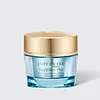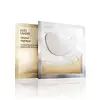What's inside
What's inside
 Key Ingredients
Key Ingredients

 Benefits
Benefits

 Concerns
Concerns

 Ingredients Side-by-side
Ingredients Side-by-side

Water
Skin ConditioningDimethicone
EmollientGlycerin
HumectantPolysorbate 60
EmulsifyingButyrospermum Parkii Butter
Skin ConditioningHydrogenated Polydecene
EmollientPropanediol
SolventSqualane
EmollientSorbitan Stearate
EmulsifyingCetyl Palmitate
EmollientTridecyl Stearate
EmollientLaminaria Saccharina Extract
Skin ProtectingLaminaria Ochroleuca Extract
Skin ConditioningGentiana Lutea Root Extract
Skin ConditioningHydrolyzed Rice Bran Extract
Skin ConditioningCitrus Reticulata Peel Extract
Skin ConditioningPsidium Guajava Fruit Extract
AstringentHydrolyzed Rice Extract
Skin ConditioningCitrus Limon Fruit Extract
MaskingFumaria Officinalis Flower/Leaf/Stem Extract
Skin ConditioningTriticum Vulgare Germ Extract
Skin ConditioningHordeum Vulgare Extract
EmollientPolygonum Cuspidatum Root Extract
AntioxidantThermus Thermophillus Ferment
Skin ConditioningCoffea Arabica Seed Extract
MaskingVitis Vinifera Seed Extract
AntimicrobialSaccharomyces Lysate Extract
HumectantLimonium Vulgare Flower/Leaf/Stem Extract
Skin ConditioningEthylbisiminomethylguaiacol Manganese Chloride
AntioxidantPalmitoyl Hydroxypropyltrimonium Amylopectin/Glycerin Crosspolymer
Skin ConditioningArtemia Extract
Skin ConditioningCholesterol
EmollientAlgae Extract
EmollientLinoleic Acid
CleansingDimethiconol
EmollientIsohexadecane
EmollientSodium Hyaluronate
HumectantLecithin
EmollientTridecyl Trimellitate
EmollientLauryl Alcohol
EmollientGlycyrrhetinic Acid
Skin ConditioningTrehalose
HumectantSucrose
HumectantErgothioneine
AntioxidantAcrylates/C10-30 Alkyl Acrylate Crosspolymer
Emulsion StabilisingDipentaerythrityl Hexacaprylate/Hexacaprate
EmulsifyingAcetyl Glucosamine
Skin ConditioningEthylhexylglycerin
Skin ConditioningButylene Glycol
HumectantGlyceryl Stearate
EmollientBehenyl Alcohol
EmollientCaffeine
Skin ConditioningPalmitic Acid
EmollientSodium PCA
HumectantStearic Acid
CleansingUrea
BufferingCaprylic/Capric Triglyceride
MaskingAcrylamide/Sodium Acryloyldimethyltaurate Copolymer
Emulsion StabilisingTocopheryl Acetate
AntioxidantTetrahexyldecyl Ascorbate
AntioxidantCetyl Alcohol
EmollientMyristyl Alcohol
EmollientPolyquaternium-51
Skin ConditioningCitric Acid
BufferingSodium Hydroxide
BufferingPolysorbate 80
EmulsifyingSodium Benzoate
MaskingFumaric Acid
BufferingCyclodextrin
AbsorbentParfum
MaskingDisodium EDTA
BHT
AntioxidantPhenoxyethanol
PreservativeChlorphenesin
AntimicrobialLinalool
PerfumingButylphenyl Methylpropional
PerfumingHydroxyisohexyl 3-Cyclohexene Carboxaldehyde
MaskingBenzyl Salicylate
PerfumingCI 42090
Cosmetic ColorantCI 19140
Cosmetic ColorantWater, Dimethicone, Glycerin, Polysorbate 60, Butyrospermum Parkii Butter, Hydrogenated Polydecene, Propanediol, Squalane, Sorbitan Stearate, Cetyl Palmitate, Tridecyl Stearate, Laminaria Saccharina Extract, Laminaria Ochroleuca Extract, Gentiana Lutea Root Extract, Hydrolyzed Rice Bran Extract, Citrus Reticulata Peel Extract, Psidium Guajava Fruit Extract, Hydrolyzed Rice Extract, Citrus Limon Fruit Extract, Fumaria Officinalis Flower/Leaf/Stem Extract, Triticum Vulgare Germ Extract, Hordeum Vulgare Extract, Polygonum Cuspidatum Root Extract, Thermus Thermophillus Ferment, Coffea Arabica Seed Extract, Vitis Vinifera Seed Extract, Saccharomyces Lysate Extract, Limonium Vulgare Flower/Leaf/Stem Extract, Ethylbisiminomethylguaiacol Manganese Chloride, Palmitoyl Hydroxypropyltrimonium Amylopectin/Glycerin Crosspolymer, Artemia Extract, Cholesterol, Algae Extract, Linoleic Acid, Dimethiconol, Isohexadecane, Sodium Hyaluronate, Lecithin, Tridecyl Trimellitate, Lauryl Alcohol, Glycyrrhetinic Acid, Trehalose, Sucrose, Ergothioneine, Acrylates/C10-30 Alkyl Acrylate Crosspolymer, Dipentaerythrityl Hexacaprylate/Hexacaprate, Acetyl Glucosamine, Ethylhexylglycerin, Butylene Glycol, Glyceryl Stearate, Behenyl Alcohol, Caffeine, Palmitic Acid, Sodium PCA, Stearic Acid, Urea, Caprylic/Capric Triglyceride, Acrylamide/Sodium Acryloyldimethyltaurate Copolymer, Tocopheryl Acetate, Tetrahexyldecyl Ascorbate, Cetyl Alcohol, Myristyl Alcohol, Polyquaternium-51, Citric Acid, Sodium Hydroxide, Polysorbate 80, Sodium Benzoate, Fumaric Acid, Cyclodextrin, Parfum, Disodium EDTA, BHT, Phenoxyethanol, Chlorphenesin, Linalool, Butylphenyl Methylpropional, Hydroxyisohexyl 3-Cyclohexene Carboxaldehyde, Benzyl Salicylate, CI 42090, CI 19140
Water
Skin ConditioningMethyl Gluceth-20
HumectantPEG-75
HumectantBis-PEG-18 Methyl Ether Dimethyl Silane
EmollientButylene Glycol
HumectantPropanediol
SolventGlycereth-26
HumectantCladosiphon Okamuranus Extract
Skin ConditioningSilybum Marianum Extract
Skin ConditioningEchinacea Purpurea Extract
MoisturisingGarcinia Mangostana Peel Extract
Skin ConditioningAnthemis Nobilis Flower Extract
MaskingCaffeine
Skin ConditioningCoffea Arabica Seed Extract
MaskingArtemia Extract
Skin ConditioningBetula Alba Bud Extract
Skin ConditioningPoria Cocos Sclerotium Extract
AstringentHydrolyzed Rice Extract
Skin ConditioningCamelina Sativa Seed Oil
Skin ConditioningAlgae Extract
EmollientLactobacillus Ferment
Skin ConditioningHydrolyzed Algin
Squalane
EmollientC12-15 Alkyl Benzoate
AntimicrobialYeast Extract
Skin ConditioningCaprylyl Glycol
EmollientTocopheryl Acetate
AntioxidantPEG-8 Glyceryl Isostearate
EmollientPolysorbate 20
EmulsifyingGlycine
BufferingCarbomer
Emulsion StabilisingSodium Hyaluronate
HumectantDextrin
AbsorbentXanthan Gum
EmulsifyingSodium Hydroxide
BufferingLecithin
EmollientTriethoxycaprylylsilane
Polyhydroxystearic Acid
EmulsifyingTrisodium EDTA
Phenoxyethanol
PreservativeCI 77491
Cosmetic ColorantWater, Methyl Gluceth-20, PEG-75, Bis-PEG-18 Methyl Ether Dimethyl Silane, Butylene Glycol, Propanediol, Glycereth-26, Cladosiphon Okamuranus Extract, Silybum Marianum Extract, Echinacea Purpurea Extract, Garcinia Mangostana Peel Extract, Anthemis Nobilis Flower Extract, Caffeine, Coffea Arabica Seed Extract, Artemia Extract, Betula Alba Bud Extract, Poria Cocos Sclerotium Extract, Hydrolyzed Rice Extract, Camelina Sativa Seed Oil, Algae Extract, Lactobacillus Ferment, Hydrolyzed Algin, Squalane, C12-15 Alkyl Benzoate, Yeast Extract, Caprylyl Glycol, Tocopheryl Acetate, PEG-8 Glyceryl Isostearate, Polysorbate 20, Glycine, Carbomer, Sodium Hyaluronate, Dextrin, Xanthan Gum, Sodium Hydroxide, Lecithin, Triethoxycaprylylsilane, Polyhydroxystearic Acid, Trisodium EDTA, Phenoxyethanol, CI 77491
 Reviews
Reviews

Alternatives
Ingredients Explained
These ingredients are found in both products.
Ingredients higher up in an ingredient list are typically present in a larger amount.
Algae Extract is a confusing name. This is because algae is an informal term for a group of 30,000 aquatic organisms that can photosynthesize.
The term 'algae extract' can refer to any one, or a blend of, the 30,000 types.
Algae is rich in antioxidants. Antioxidants help fight free-radicals. Free-radicals are molecules that may damage your skin cells, such as pollution.
Algae can also help with soothing and hydrating skin.
Many different types of algae have different benefits.
Learn more about Algae ExtractWe don't have a description for Artemia Extract yet.
Butylene Glycol (or BG) is used within cosmetic products for a few different reasons:
Overall, Butylene Glycol is a safe and well-rounded ingredient that works well with other ingredients.
Though this ingredient works well with most skin types, some people with sensitive skin may experience a reaction such as allergic rashes, closed comedones, or itchiness.
Learn more about Butylene GlycolCaffeine is most associated with coffee, tea, and cacao. In skincare, it helps with calming inflammation and is rich in antioxidants.
While caffeine is used to treat cellulite and and dark circles, further studies are needed to prove this. It has been believed to help with these skin conditions due to its ability to dilate blood vessels and increase blood flow.
Some studies are looking into caffeine's ability to protect against UV rays.
Learn more about CaffeineThis ingredient is more commonly known as the coffee bean from the Coffea Arabica tree. Besides being a delicious drink, coffee beans have a ton of skin benefits.
Coffea Arabica Seed Extract (CASE) has antioxidant, anti-inflammatory, and UV-protective properties. (It should not replace your sunscreen!)
CASE contains several ingredients that protect and soothe skin. These include caffeine, polysaccharides, sucrose, lipids, minerals, and proteins.
The star ingredient in coffee is caffeine.
Caffeine helps with anti-aging, antioxidant, and photo-protection.
How? It has been shown to block collagenase (~41%), elastase (~35%), and tyrosinase (~13%).
Collagenase and elastase are enzymes that break down collagen and elastin, respectively. Tyrosinase is the enzyme that controls melanin production.
Our skin creates melanin when exposed to UV as a defense mechanism.
It should be noted most studies looked at caffeine's ability to inhibit damage from UV-B rays.
According to a manufacturer, this ingredient is often dissolved using water, glycerin, and propanediol. The caffeine content of this ingredient is about 100 ppm.
Coffea Arabica is native to Ethiopia.
Learn more about Coffea Arabica Seed ExtractHydrolyzed rice protein is a plant-derived ingredient with hydrating, antibacterial and anti-aging properties.
This fine, white-ish powder is protein rich. The protein is hydrolyzed into smaller peptides and amino acids.
It has the following skin benefits:
In hair care, this ingredient can help reduce breakage, enhance shine, and reduce frizz.
Read more about the benefits of rice extract here.
Learn more about Hydrolyzed Rice ExtractLecithin is a term for a group of substances found in the cell membranes of plants, animals, and humans. They are made up of mixture of phospholipids.
This ingredient has emollient and emulsifying properties.
As an emollient, lecithen helps soften the skin and creates a barrier to keep moisture in.
As an emulsifier, it also helps prevent water and oil ingredients from separating. Lecithin can also help ingredients be better absorbed by the skin.
This is because the phospholipids in lecithin produce liposomes. Liposomes help other ingredients get through the skin barrier.
Depending on the source of this ingredient, lecithin may not be fungal acne safe. This is because some sources of lecithin come from soybean oil, which may feed the malassezia yeast that feeds fungal acne.
We recommend reaching out to the brand you are purchasing from to inquire about the source of their lecithin.
Some other names for this ingredient include soy lecithin and deoiled soy lecithin.
Learn more about LecithinPhenoxyethanol is a preservative that has germicide, antimicrobial, and aromatic properties. Studies show that phenoxyethanol can prevent microbial growth. By itself, it has a scent that is similar to that of a rose.
It's often used in formulations along with Caprylyl Glycol to preserve the shelf life of products.
Propanediol is an all-star ingredient. It softens, hydrates, and smooths the skin.
It’s often used to:
Propanediol is not likely to cause sensitivity and considered safe to use. It is derived from corn or petroleum with a clear color and no scent.
Learn more about PropanediolSodium Hyaluronate is hyaluronic acid's salt form. It is commonly derived from the sodium salt of hyaluronic acid.
Like hyaluronic acid, it is great at holding water and acts as a humectant. This makes it a great skin hydrating ingredient.
Sodium Hyaluronate is naturally occurring in our bodies and is mostly found in eye fluid and joints.
These are some other common types of Hyaluronic Acid:
Learn more about Sodium HyaluronateSodium Hydroxide is also known as lye or caustic soda. It is used to adjust the pH of products; many ingredients require a specific pH to be effective.
In small amounts, sodium hydroxide is considered safe to use. However, large amounts may cause chemical burns due to its high alkaline.
Your skin has a natural pH and acid mantle. This acid mantle helps prevent harmful bacteria from breaking through. The acid mantle also helps keep your skin hydrated.
"Alkaline" refers to a high pH level. A low pH level would be considered acidic.
Learn more about Sodium HydroxideSqualane is an emollient that helps the skin hold onto moisture. It's an oily liquid that occurs naturally in certain types of fish and plant oils.
Because squalane boosts hydration in the skin, it also comes with plenty of benefits: it is an antioxidant and can help fight free radicals and skin damage. Squalane is also found to have a detoxifying effect when applied.
Squalane comes from squalene, which occurs naturally within the sebum of our skin. It is one of the oils our skin produces to keep itself hydrated. Squalane is the hydrogenated version of squalene and has a longer shelf life.
Research shows that squalane is non-irritating (even at 100% concentration).
In general, it's a fantastic ingredient. It does a great job at hydrating the skin, and it's suitable for those with sensitive skin.
The source of squalane may impact malassezia / fungal acne. This is because olive oil derived squalane can contain impurities such as fatty acids and plant waxes. Sugarcane derived squalane is recommended for anyone with malassezia concerns.
Is squalane vegan?
This depends on the source. Squalane can be derived from both plants and animals. Most squalane used in skincare comes from plants.
Please note: the source of squalane is only known if disclosed by the brand. We recommend reaching out to the brand if you have any questions about their squalane.
Read more about squalene with an "e".
Is squalane an oil?
Squalane is often called an oil, but it’s technically not; it’s a hydrocarbon, meaning it’s only made of carbon and hydrogen, unlike true oils which are triglycerides made of fatty acids and glycerol.
The term “oil-free” isn’t regulated, so companies can define it however they want. Some exclude all oils, while others just avoid mineral oil or comedogenic oils.
While some people avoid oils thinking they cause breakouts, the right kind of oil (or oil-like ingredient like squalane) can actually help balance and hydrate your skin. It’s worth testing out simple oils or squalane to see what works best for your skin.
Learn more about SqualaneTocopheryl Acetate is AKA Vitamin E. It is an antioxidant and protects your skin from free radicals. Free radicals damage the skin by breaking down collagen.
One study found using Tocopheryl Acetate with Vitamin C decreased the number of sunburned cells.
Tocopheryl Acetate is commonly found in both skincare and dietary supplements.
Learn more about Tocopheryl AcetateWater. It's the most common cosmetic ingredient of all. You'll usually see it at the top of ingredient lists, meaning that it makes up the largest part of the product.
So why is it so popular? Water most often acts as a solvent - this means that it helps dissolve other ingredients into the formulation.
You'll also recognize water as that liquid we all need to stay alive. If you see this, drink a glass of water. Stay hydrated!
Learn more about Water